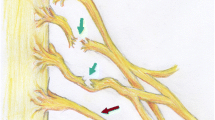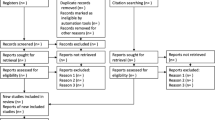Abstract
Background
There is no consensus about which type of imaging study, computed tomography myelography (CTM) or magnetic resonance imaging (MRI), provides better information concerning root avulsion in adult brachial plexus injuries.
Methods
Patients with upper brachial plexus traumatic injuries underwent both CTM and MRI and surgical exploration. The imaging studies were analyzed by two independent radiologists and the data were compared with the intraoperative findings. The statistical analysis was based on dichotomous classification of the nerve roots (normal or altered). The interobserver agreement was assessed using Cohen’s Kappa. The accuracy of CTM and MRI in comparison with the intraoperative findings was evaluated using the same methodology.
Results
Fifty-two adult patients were included. CTM tended to yield slightly higher percentages of alterations than MRI The interobserver agreement was better on CTM than on MRI for all nerve roots: C5, 0.9960 (strong) vs. 0.145 (poor); C6, 0.970 (strong) vs. 0.788 (substantial); C7, 0.969 (strong) vs. 0.848 (strong). The accuracy regarding the intraoperative findings was also higher on CTM (moderate, kappa 0.40–0.59) than on MRI (minimal, kappa 0.20–0.39) for all nerve roots. Accordingly, the overall percentage concordance (both normal or both altered) was superior in the CTM evaluation (approx. 70–75% vs. 60–65%). CTM was superior for both sensitivity and specificity at all nerve roots.
Conclusion
CTM had greater interobserver agreement and higher diagnostic accuracy than MRI in adult patients with root avulsions due to brachial plexus injury.



Similar content being viewed by others
Abbreviations
- CTM:
-
Computed tomography myelography
- MRI:
-
Magnetic resonance imaging
References
Faglioni W Jr, Siqueira MG, Martins RS, Heise CO, Foroni L (2014) The epidemiology of adult traumatic brachial plexus lesions in a large metropolis. Acta Neurochir 156:1025–1028
Moran SL, Steinmann SP, Shin AY (2005) Adult brachial plexus injuries: mechanism, patterns of injury, and physical diagnosis. Hand Clin 21:13–24
Abul-Kasim K, Backman C, Björkman A, Dahlin LB (2014). Advanced radiological work-up as an adjunct to decision in early reconstructive surgery in brachial plexus injuries. J Brachial Plex Peripher Nerve Inj 2010; 5:14
Belzberg AJ, Storm PB, Moriarity JH (2004) Surgical repair of brachial plexus injury: a multinational survey of experienced peripheral nerve surgeons. J Neurosurg 101:365–376
Giuffre JL, Kakar S, Bishop AT, Spinner RJ, Shin AY (2010) Current concepts of the treatment of adult brachial plexus injuries. J Hand Surg Am 35:678–688
Ozdoba C, Rieke A, Binggeli R, Schroth G (2011) Myelography in the age of MRI: why we do it, and how we do it. Radiol Res Pract Art #329017
Walker AT, Chaloupka JC, de Lotbiniere AC, Wolfe SW, Goldman R, Kier EL (1996) Detection of nerve rootlet avulsion on CT myelography in patients with birth palsy and brachial plexus injury after trauma. AJR Am J Roentgenol 167:1283–1287
Bowen BC, Pattany PM, Saraf-Lavi MKR (2004) The brachial plexus normal anatomy, pathology, and MR imaging. Neuroimaging Clin N Am 14:59–85
Gasparotti R, Garozzo D, Ferraresi S. Radiographic assessment of adult brachial plexus injuries (2012) In: Chung KC, Yang LJS, McGillicudy JE (eds): Practical management of pediatric and adult brachial plexus palsies. New York: Elsevier Saunders, pp 234–248
Gerevini S, Mandelli C, Cadioli M, Scotti G (2008) Diagnostic value and surgical implications of the magnetic resonance imaging in the management of adult patients with brachial plexus pathologies. Surg Radiol Anat 30:91–101
Van Es HW, Bollen TL, van Heesewijk HPM (2010) MRI of the brachial plexus: a pictorial review. Eur J Radiol 74:391–402
Yang J, Qin G, Fu G, Li P, Zhu Q, Liu X, Zhu J, Gu L (2013) Modified pathological classification of brachial plexus root injury and its MR imaging characteristics. J Reconstr Microsurg 30:171–178
Yoshikawa MI, Hayashi N, Yamamoto S, Tajiri Y, Yoshioka N, Masumoto N, Mori H, Abe O, Aoki S, Ohtomo K (2006) Brachial plexus injury: clinical manifestations, conventional image findings, and the latest imaging techniques. Radiographics 26(Suppl 1):S133–S143
Doi K, Otsuka K, Okamoto Y, Fujii H, Hattori Y, Baliarsing AAS (2002) Cervical nerve root avulsion in brachial plexus injuries: magnetic resonance imaging classification and comparison with myelography and computerized tomography myelography. J Neurosurg 96:277–284
Silberman-Hoffman O, Teboul F (2013) Post-traumatic brachial plexus MRI in practice. Diag Intervent Imaging 94:925–943
Tagliafico A, Succio G, Serafini G, Marinoli C (2012) Diagnostic accuracy of MRI in adults with suspect brachial plexus lesions: a multicenter retrospective study with surgical findings and clinical follow-up as reference standard. Eur J Radiol 81:2666–2672
Wade RG, Itte V, Rankine JJ, Ridgway JP, Bourke G (2017) The diagnostic accuracy of 1.5T magnetic resonance imaging for detecting root avulsions in traumatic adult brachial plexus injuries. J Hand Surg Eur 43:250–258
Carvalho GA, Nikkhah G, Matthies C, Penkert G, Samii M (1997) Diagnosis of root avulsions intraumatic brachial plexus injuries: value of computerized tomography and magnetic resonance imaging. J Neurosurg 86:69–76
Marshall RW, De Silva RD (1986) Computerized axial tomography in traction injuries of the brachial plexus. J Bone Joint Surg Br 68:734–738
Rankine JJ (2004) Adult traumatic brachial plexus injury. Clin Radiol 59:767–774
Yamazaki H, Doi K, Hattori Y, Sakamoto S (2007) Computerized tomography with coronal and oblique coronal view for diagnosis of nerve root avulsion in brachial plexus injury. J Brachial Plex Peripher Nerve Inj 2:16
Wade RG, Takwoingi Y, Wormald JCR, Tanner SF, Ridgway JP, Rankine J, Bourke G (2019) Magnetice resonance imaging for detecting root avulsions in traumatic adult brachial plexus injuries: a systematic review and meta-analysis of diagnostic accuracy. Radiology 293:125–133
Silberman-Hoffman O, Goeffroy O, Tubach L, Bensoussan S, Teboul F, Schouman C (2003) 3D Fiesta-pc MRI myelography of traumatic injuries of the brachial plexus. Scientific poster RSNA
Smith AB, Gupta N, Strober J, Chin C (2008) Magnetic resonance neurography in children with birth-related brachial plexus injury. Pediatr Radiol 38:159–163
Laohaprasitiporn P, Wongtrakul S, Vathana T, Limthongthang R, Songcharoen P (2018) Is pseudomeningocele an absolute sign of root avulsion brachial plexus injury? J Hand Surg (Asina-Pacific Vol) 23:360–363
Chanlalit C, Vipuilakorn K, Jiraruttanapochai K, Mairiang E, Chowcheun P (2005) Value of clinical findings, electrodiagnosis and magnetic resonance imaging in the diagnosis of root lesions in traumatic brachial plexus injuries. J Med Assoc Thail 88:66–70
Dubuisson AS, Kline DG (2002) Brachial plexus injury: a survey of 100 consecutive cases from a single service. Neurosurgery 51:673–682
Gasparotti R, Ferraresi S, Pinelli L, Crispino M, Pavia M, Bonetti M, Garozzo D, Manara O, Chiesa A (1997) Three-dimensional MRI myelography of traumatic injuries of the brachial plexus. AJNR Am J Neuroradiol 18:1733–1742
Hayashi N, Yamamoto S, Okubo T, Yoshioka N, Shirouzu I, Abe O, Ohtomo K, Sasaki Y, Nagano A (1998) Avulsion injury of cervical nerve roots at MR imaging. Radiology 206:817–822
Hems T, Birch R, Carlstedt T (1999) The role of magnetic resonance imaging in the management of traction injuries to the adult brachial plexus. J Hand Surg Br 24:550–555
Nakamura T, Yabe Y, Horiuchi Y (1997) Magnetic resonance myelography in brachial plexus injury. J Bon Joint Surg Br 79:64–769
Qin G, Yang JT, Yang Y, Wang HG, Fu G, Gu LQ, Li P, Zhu QT, Liu XL, Zhu JK (2016) Diagnostic value and surgical implications of the 3D DW-SSFP MRI on the management of patients with brachial plexus injuries. Sci Rep 6:3599
Linde EVD, Naidu V, Mitha A, Rocher A (2015) Diagnosis of nerve root avulsion injuries in adults with traumatic brachial plexopathies: MRI compared with CT myelography. South Afr J Radiol 19:1–9
Author information
Authors and Affiliations
Corresponding author
Ethics declarations
Conflict of interest
The authors declare that they have no conflict of interest.
Ethical approval
All procedures performed in studies involving human participants were in accordance with the ethical standards of the institutional and/or national research committee and with the 1964 Helsinki declaration and its later amendments or comparable ethical standards.
Additional information
Comments
The article by Bordalo-Rodrigues et al. is a prospective study to examine the differences between MRI (with 3D FIESTA) and CT myelography in investigating the existence of nerve root avulsion related to traumatic brachial plexus injury. This is an important topic that needs to be revisited periodically as MRI and CT technology improves. The authors made great effort in study design and presented confirmatory data that, at least at the present time and in their practice settings, CT myelography remains the gold standard in diagnosing nerve root avulsion.
At our institution, we continue to use CT myelography preferentially as part of the diagnostic work-up of patients with severe proximal brachial plexus injuries. Imaging in these patients complements the clinical history, physical examination, and electromyography (EMG) and nerve conduction studies. While preoperative imaging is of great utility, we then correlate the imaging findings with intraoperative electrodiagnostic testing including somatosensory and motor evoked potentials (SSEPs and MEPs) in testing preganglionic injury, and nerve action potentials and EMG in postganglionic injury. At this time where nerve transfers are directing some surgeons away from the supraclavicular brachial plexus, whether for pre or postganglionic injury (particularly in patients with upper pattern lesions), we still routinely explore the plexus, perform intraoperative recordings and hope to find a viable cervical spinal nerve stump for reconstruction of the shoulder (i.e., maintaining spinal accessory nerve and trapezius function for possible secondary reconstruction); we typically perform distal nerve (fascicular) transfer(s) for elbow flexion based on the consistently improved outcomes with this procedure.
Advances in diagnosing nerve root avulsion with MRI are well on their way. Higher resolution with 3T and 7T MRI and newer imaging protocols continue to be developed. Newer steady-state free-precession methods of MRI signal acquisition are being applied to the brachial plexus. These newer technologies are still primarily seen at only tertiary and quaternary care centers, although MR myelography has become more widely available. The future of imaging is bright for further refining the techniques to assess suspected preganglionic injury.
Nikhil Murthy,
Robert J. Spinner,
Rochester, MN, USA
Publisher’s note
Springer Nature remains neutral with regard to jurisdictional claims in published maps and institutional affiliations.
This article is part of the Topical Collection on Peripheral Nerves
Rights and permissions
About this article
Cite this article
Bordalo-Rodrigues, M., Siqueira, M.G., Kurimori, C.O. et al. Diagnostic accuracy of imaging studies for diagnosing root avulsions in post-traumatic upper brachial plexus traction injuries in adults. Acta Neurochir 162, 3189–3196 (2020). https://doi.org/10.1007/s00701-020-04465-9
Received:
Accepted:
Published:
Issue Date:
DOI: https://doi.org/10.1007/s00701-020-04465-9




